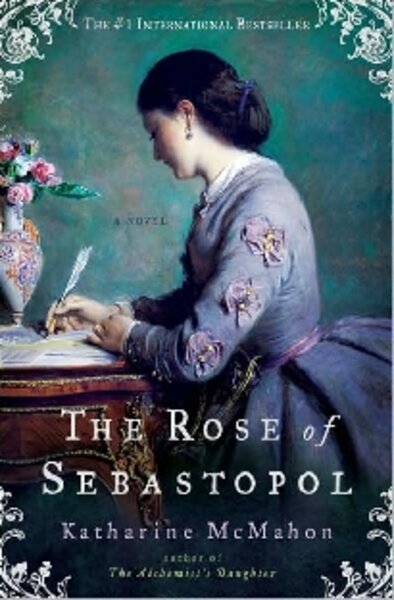The Rose of Sebastopol
Loading...
When it comes to 19th-century heroines, modern readers expect them to be ahead of their time. They are either tomboy geniuses like Jo March, who chafe at the narrow roles women were expected to fill, or sparkling wits who aren’t afraid to speak their mind, such as Lizzy Bennet and Marianne Dashwood.
If they are shy on the surface, like Jane Eyre, that’s only because they’re concealing a fiery temper and unsuspected depths.
Then there’s Mariella Lingwood. Timid and judgmental, she craves society’s approval. She’s not bookish or artistic. Instead, she’s a whiz at sewing. (It’s hard to think of a more genteel occupation at which to be a prodigy. Arranging ferns? Painting china?)
Mariella may be no Mary Wollstonecroft-reading bluestocking, but she can embroider a set of towels faster than most of her peers can down a cup of tea.
But this stay-at-home mouse travels to some of the deadliest battlefields of Europe in Katharine McMahon’s highly entertaining historical novel, The Rose of Sebastopol.
Mariella’s beloved cousin, Rosa, is far more suited to the role of heroine. Beautiful, opinionated, and impatient with the restrictions of Victorian mores, Rosa is determined to follow in the footsteps of her hero, Florence Nightingale. Despite discouragement from everyone – including Miss Nightingale, who had no use for pretty young idealists – she sails off for the Crimea with a bunch of volunteers. (Mariella’s war efforts? She’s making a scrapbook.)
Mariella’s fiance, Dr. Henry Thewell, is already there, serving in the understaffed, underequipped hospitals of that woeful war. That they are so nightmarishly unprepared is partly Henry’s fault: He’d been part of an advance team that was supposed to get everything ready.
However, the civilian surgeons were unable to imagine either the scope of the casualties, the bitterness of winter in Russia, or the possibility of cholera. The exalted medical minds also forgot that wounded men need bandages.
“Imagine a building the size of one of your new London railway stations, just as empty but a hundred times dirtier and older, the only provisions a handful of bedsteads, a few sacks, and a dozen bottles of port,” Rosa writes to Mariella in one of the few letters that make it back to England. “Imagine that a couple of steamers come puffing and snorting up to the ramshackle jetty outside and discharge 300 wounded men, each in need of warmth and sustenance and skilled nursing. Imagine that what they find instead are half a dozen Rosas and a clutch of nuns, all more or less empty-handed and in a state of shock. That’s the hospital at Koulali.”
“The Rose of Sebastopol” opens with Mariella traveling to Italy in 1855, to visit an ailing Henry. Their reunion is more romantic than Mariella ever dreamed – until a delirious Henry moans Rosa’s name. Once he regains consciousness, he explains that Rosa disappeared and has been missing for months.
Henry, himself, seems blasted in both his health and ideals.
“I hacked off body parts and called it surgery,” he tells Mariella. “Dear God, I could have saved so much pain, in my time, had I been issued with a pistol so that I could have shot all my patients in the head and had done with it.”
While it’s hard to even imagine Mariella getting her petticoats muddy, she heads for the Crimea – ruffles, needle case, and all – in search of Rosa. Had Jo March run off to the Civil War, like she threatened, and shy Beth had come to her rescue, the result might be something similar.
While Mariella tries to find Rosa (and discover just what happened between her and Henry), “The Rose of Sebastopol” jumps back in time to Rosa’s and Mariella’s first meeting as children and to the more recent past, when Rosa and her invalid mother come to live with Mariella’s family.
Also searching for Rosa is her stepbrother Max, now a cynical captain in the Crimean War, and their stalwart nurse, Nora, who basically hauls Mariella onto the ship to Russia.
While the novel is marred by an overly abrupt ending, McMahon’s social commentary adds welcome bite. The lives of cottagers forced to drink water near her stepfather’s lead works appalls 12-year-old Rosa as much as the conditions she sees once she arrives in the Crimea as an adult.
McMahon includes newspaper clippings about the privations facing soldiers, including a caustic Times editorial informing Londoners that the British military has forbidden chaplains to pass out the donated clothes sent to protect soldiers from frostbite.
“Surely,” said Mrs. Hardcastle, head of the charity that Mariella’s mom belongs to, “what with steamships and railways and telegraph and factories, it is not beyond the wit of man to get a few pairs of socks to Russia and then have them distributed through the proper channels.”
Once in the Crimea, Mariella doesn’t suddenly become a cross between Sherlock Holmes and, well, Florence Nightingale: She’s still prim, shy, and lousy on horseback.
Part of the charm of “The Rose of Sebastopol” is how the extremity of her situation allows Mariella to discover reserves of strength she never needed while helping her mother outfit a home for retired governesses and waiting years (and years) to marry Henry.
For the first time in her life, she’s able to stop being ornamental and finally become what Rosa always longed to be: useful.
Yvonne Zipp regularly reviews fiction for the Monitor.






